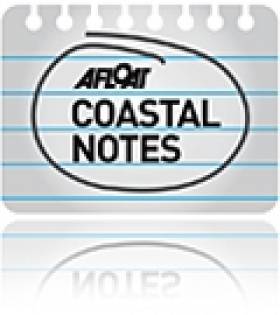Displaying items by tag: UK Naval Tanker
RFA ‘Atlantic Patrol Tasking North’ Replenishment at Sea Tanker Offshore of Greystones
#UKNavalTanker - RFA Wave Knight (A389) a 31,500dwt tanker which supplies the Royal Navy was some 20 nautical miles offshore of Greystones Harbour during a mid-week northbound passage in the Irish Sea, writes Jehan Ashmore.
The 10,000nm range Royal Fleet Auxiliary (RFA) vessel with a crew of 72, is the leadship of the 'Wave Knight' class of Fast Fleet Tankers that had departed Plymouth.
The vessel has not called to any Irish Port but is currently deployed on operation 'Atlantic Patrol Tasking North'.
She is also used to serve global operations, where the RFA Wave Knight provides fuel, food, fresh water, ammunition and other supplies in addition to support amphibious forces, anti-surface and anti-submarine warfare operations.
To carry out refuelling, RAS (Replenishment at sea) this is carried out through a hose-pipe rig, to a vessel either to port or starboard and also can be conducted astern.
Another role of the 196m vessel is to carry out helicopter missions on humanitarian relief events and also weapons systems operations. This requires 26 Royal Navy personnel for helicopter operations, noting the stern-landing deck and hanger as pictured HERE of the vessel.
Launched in 2000 at VSEL, Barrow-On-Furness, the Cumbrian port on the Irish Sea switched ownership during Wave Knight's fit-out. So by the time the 16,900 tonnes fuel capacity tanker was accepted into RFA service in 2003 this was then during control of BAE Systems Marine.
She is the second ship to bear this name in RFA service and her sister RFA Wave Ruler (A390) was also named after a previous oiler replenishment tanker. As previously reported, RFA Gold Rover (A271) another RAS tanker made a visit to Dublin Port last year.
Also reported was this week's visit of the French Navy's BCR Somme (A 631) to Dublin Port. The auxiliary oil replenishment tanker (AOR) again another term for this type of naval support vessel is seen carrying out a RAS operation as captured by clicking this VIDEO link.
It was during the four-day visit that the French Ambassador to Ireland presented the Legion d'Honneur to Michael 'Mickey' d'Alton's contribution to the success of D-Day in 1944.
For much more about one of the last Irish survivors of this critical event during WW2, Afloat's W. M. Nixon reflects on some very special stories of this senior Dun Laoghaire sailor.
Following the ceremony, the Somme departed Dublin Port last Tuesday morning.
The Brest-based ship which is home-ported in the Breton naval base to carry out her area of operations in the Atlantic, was instead understood to be bound for another base in Toulon on the Mediterranean.
#RFArefits - Cammell Laird, the Merseyside shipyard completed a £49.5m major refit of Royal Fleet Auxiliary's Fort Victoria (A387), one of the largest vessels operated by the UK Ministry of Defence, writes Jehan Ashmore.
The 10 month refit of the 16,967dwt oiler auxiliary replenishment (AOR) vessel that includes carrying stores and ammunition, was the largest single contract for Cammell Laird in 2014 and since the yard began in 2008 its life support 'cluster' contract to maintain nine of the 13 RFA flotilla.
Already refitted at the yard the oil tanker, RFA Gold Rover (A271) which Afloat.ie reported on of her Dublin Port visit last August.
Work on the Harland & Wollf built RFA Fort Victoria was extensive and among the refit's to do list, this involved overhauling the main engines and upgrading of power generation systems that required steelwork and pipework for both fresh and salt water.
Added to this the 'Fort' class vessel launched in 1990 had the blasting of old and applying of new paint within the hull's ballast and cargo tanks and to the exterior that also included the superstructure.
Following her refit, RFA Fort Victoria made a short hop across the Mersey to Liverpool Docks and remained there for several days prior to sailing to Scottish waters.
The contract with Cammell Laird, also provides capability insertion allowing the ships to be fully integrated with the Royal Navy.
In September, RFA Diligence (A132) returned from much warmer climes for her refit period which is scheduled to be completed early next month.
Every five years the cluster contract is reviewed based on performance and value for money and the Merseyside facility was given an extension of the contract in November 2012 for a further five years to 2018.
As part of the global reach element to the contract, Cammell Laird will also deliver extensive support to the RFA fleet around the world.

























































